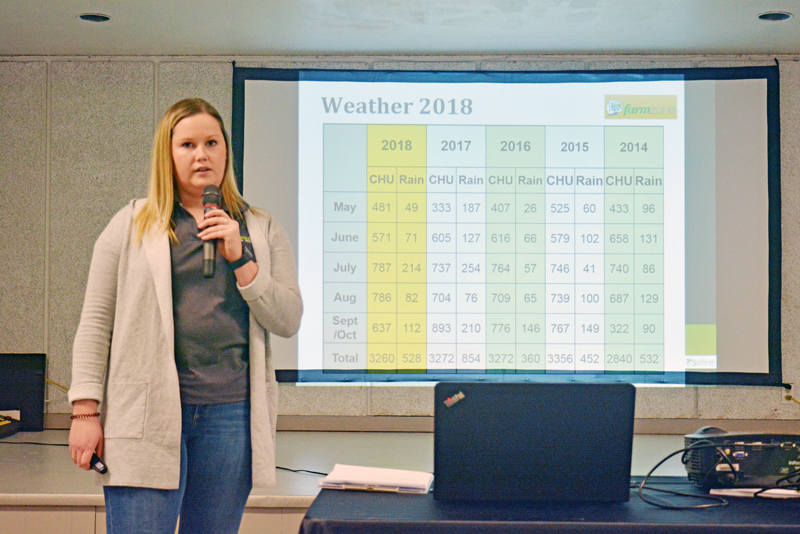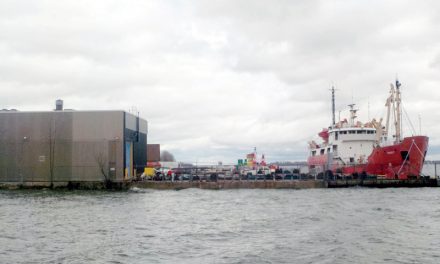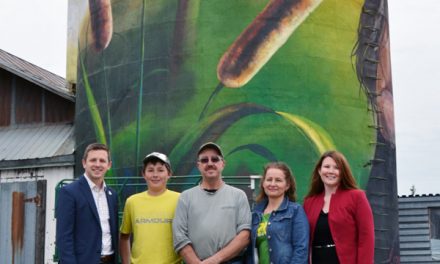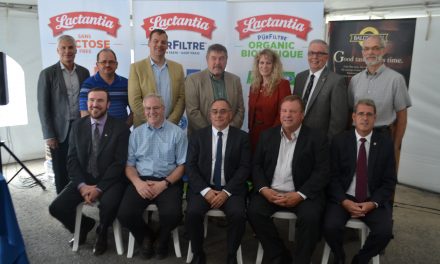Lindsay Clarke from PT Sullivan Agro discussed how the weather changes in the past four years have helped the increase in corn and soybean crop yields. Glover photo

Glover photos
WINCHESTER – Lindsay Clarke, Mike Sullivan and Stephanie Nanne from PT Sullivan Argo attended Precision Planting’s latest conference Wed., Jan. 30 at the Joel Steele Community Centre to discuss the increased yields in soybean and corn fields.
Clarke started the presentation by going into the background of weather from 2014 to 2018, showing how much warmer it has gotten in that four year stretch, showing crop heat units (CHU).
“From 2014 to 2018, you can see that we have over 3,000 heat units that we accumulated in 2018, similar to the past three years,” she said. “We had a lot more heat units in May and we had more rain in April which delayed us from getting into the fields but we did have less rain in 2018 than the previous year, so we were able to get in about 10 days earlier.”
Clarke displayed a chart of the CHU accumulated between May and October, between the years 2014 and 2018. From the data collected, the total amount of heat units collected in 2014 was 2,840, 420 units less than last year’s total of 3,260.
Dueto these changes, there have been significant increases in yields in both corn and soybean crops.
“The counties of SDG were closer to their per cent normal than we were. We’ve hit some record yields on each farm, we had some even fields that recorded 80 bushels per acre and most farms were able to get about 10 bushels more per acre, more than what they could last year and, if not, increase their overall farm average by 10 bushels,” said Clarke. “For corn, we saw similar trends, going up in yields, closer to our per cent normal but still very good. We had some of the weather at the front of the season that really kept a hold on the corn crop yields. The most challenging time for the season was through dry periods but once we got that rain and moisture, we were able to push through to get our 2015 average.”
Clarke stated they would like to see between 30,000 to 36,000 plants per acre as their final stance for corn population.
“For soybeans, majority of us were looking towards getting our seeds into the ground earlier as they can handle the stress a lot better than the corn crops can. So we like to see beans going in earlier than what we’ve seen in the past,” she said. “We’ve also been able to see consistent beans going in early with longer season beans have been really able to add to yields at the end of the year.”
Soybean populations have been going down from 143,200 plants per acre in 2012 to 132,900 plants per acre in 2018, which is where Clarke hopes they will stay.
Sullivan continued the presentation, addressing continuing concerns with seed beds.
“Lumpy seed beds can cause poor seed to soil contact and the inconsistency causing emergence and lower crop populations,” he said. “Uneven emergence can cause plants to produce only half a cob or no cob, making the plant more of a weed than a corn plant. So, it’s more just robbing the nutrients from the plant.”
Sullivan explained that lumpy seed beds can be avoided by working the soil when it’s fit and when it’s wet, go into the field. Also adding rolling baskets to tillage implements can help break up seed clumps.
“But rolling baskets work at high speeds, if your tillage implement or your system doesn’t work at high speeds, it will be a mess,” he said. “Work with what you have and use it properly.”
Stephanie Nanne ended the presentation talking about the factor of nitrogen in increased crop yields.
“When we put nitrogen onto the soil, that nitrogen has to get into the soil solution, convert to nitrate, the form the plant uses and has to get into the plant,” she said. “Nutrients can only get into the plant through water, if there’s no water in the soil, there’s no nutrients getting into the plant.”
Nanne explained that it was important to have nitrogen in the soil solution before the plant needed it because once the ground was dry, the nitrogen wouldn’t be able to get into the plant.
“For a lot of years, the application system of nitrogen, where you’re putting it, actually trumps the rate of nitrogen that you’re putting on. It’s not always the case but we did find that a lot this year that placement is very important,” she said. “The kind of systems we have in this area that we’ve used this year and looked at are broadcast urea that could be applied at any time in the preferred time frame and Streamer UAN can be applied by the six leaf stage.”
Nanne continued into the side-dress coulter system that can apply nitrogen by the two to nine leaf stage, the side-dress Y drop that can be up to the five to nine leaf stage and side-dress Y drop SP, which can be applied up to the eight to 12 leaf stage.













